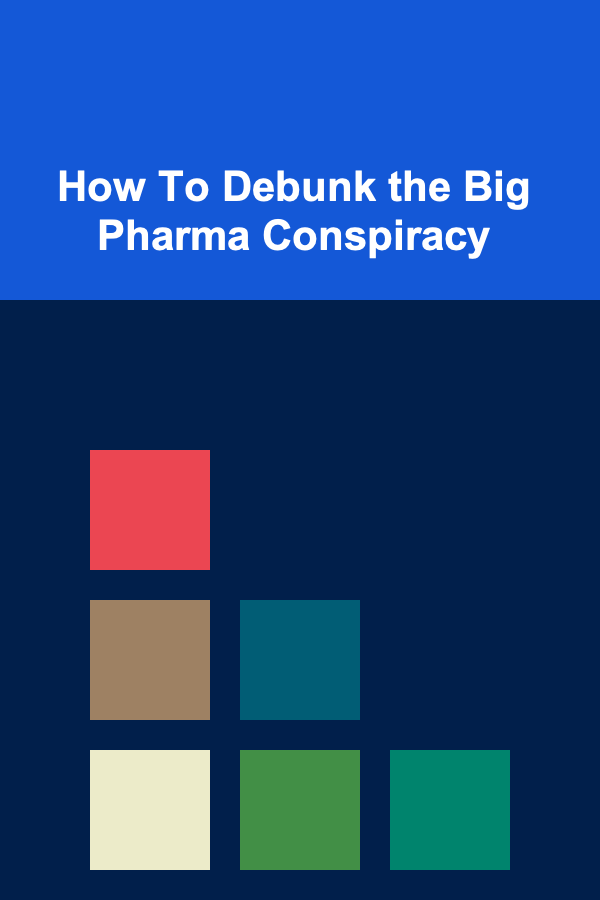
How To Debunk the Big Pharma Conspiracy
ebook include PDF & Audio bundle (Micro Guide)
$12.99$9.99
Limited Time Offer! Order within the next:

The "Big Pharma conspiracy" is one of the most pervasive and enduring theories in contemporary society. It suggests that the pharmaceutical industry, often grouped together under the term "Big Pharma," manipulates the healthcare system, suppresses cures for diseases, and prioritizes profit over patient well-being. This theory taps into a wide range of anxieties, including concerns about corporate greed, the rising costs of medical care, and the alleged power and influence of multinational pharmaceutical companies. However, the narrative surrounding the Big Pharma conspiracy often oversimplifies complex issues, misrepresents facts, and fuels distrust in scientific institutions. In this article, we will critically examine the key elements of the Big Pharma conspiracy, offer evidence-based counterarguments, and provide a more nuanced understanding of the pharmaceutical industry's role in healthcare.
Understanding the Roots of the Big Pharma Conspiracy
Before we dive into debunking the conspiracy, it's important to explore why it exists in the first place. Several factors contribute to the proliferation of these theories:
1. Distrust in Authority
One of the primary reasons people are drawn to conspiracy theories, including the Big Pharma narrative, is a fundamental distrust of authority. The pharmaceutical industry, often viewed as a powerful, profit-driven entity, can appear to be more concerned with bottom lines than patient welfare. When people feel powerless or alienated from the medical system, they may turn to alternative explanations that suggest shadowy forces are at play.
2. Rising Healthcare Costs
The skyrocketing costs of healthcare, particularly prescription drugs, have amplified skepticism surrounding the pharmaceutical industry. For many individuals, high drug prices seem to confirm the idea that Big Pharma is more interested in maximizing profits than in serving the public. This financial burden exacerbates feelings of exploitation, which feeds into the conspiracy theory.
3. Media Influence and Fearmongering
Social media platforms, blogs, and alternative news outlets have become breeding grounds for conspiracy theories. The ease with which misinformation spreads on these platforms contributes to the Big Pharma narrative. Sensational headlines, anecdotes, and cherry-picked data often mislead readers, making them more susceptible to believing the conspiracy theory.
4. Historical Scandals
While the pharmaceutical industry has undoubtedly been involved in some highly controversial and unethical practices, these incidents often get magnified by conspiracy theorists to imply that the entire industry is inherently corrupt. Examples like the opioid crisis, the marketing of antidepressants, and the Vioxx scandal contribute to the perception that the industry is driven by unethical motives.
Dissecting the Key Claims of the Big Pharma Conspiracy
The Big Pharma conspiracy theory is built upon several core claims. These include the idea that pharmaceutical companies:
- Suppress Cures for Diseases: Pharmaceutical companies allegedly keep life-saving treatments and cures hidden to maintain a steady stream of profits from ongoing treatments.
- Manipulate Research and Clinical Trials: The industry is accused of falsifying or selectively reporting data to promote drugs that may not be as effective or safe as claimed.
- Bribe Doctors and Regulators: Doctors and healthcare professionals are often depicted as being bought off by pharmaceutical companies to push their products, even when these drugs may not be in the best interest of patients.
- Prioritize Profits Over Patient Health: The idea here is that Big Pharma puts more effort into marketing and profiting from drugs than in ensuring that these drugs are truly beneficial for patients.
Let's now examine these claims one by one.
1. The Suppression of Cures
The idea that pharmaceutical companies are suppressing cures for diseases is one of the most pervasive aspects of the Big Pharma conspiracy. Conspiracy theorists often point to illnesses such as cancer, AIDS, and diabetes, arguing that cures for these conditions exist but are being hidden to protect pharmaceutical profits. The claim is often supported by anecdotal stories of "miracle cures" that are allegedly ignored or suppressed by the industry.
Debunking the Claim:
The claim that pharmaceutical companies are actively suppressing cures is highly speculative and unsupported by credible evidence. In fact, the pharmaceutical industry has invested billions of dollars in researching cures and treatments for various diseases. Cures for some diseases, like certain types of cancer, have been found, though they are often not as widely available as conspiracy theorists would hope.
The notion that a cure for cancer or any other major disease is being "suppressed" overlooks the reality of scientific research, which is often slow, methodical, and requires rigorous validation. Drug development is a long and expensive process, with many potential treatments failing at various stages of clinical trials due to safety concerns or lack of efficacy.
Furthermore, many modern treatments have extended the lives of people with chronic conditions or previously untreatable diseases. For example, the development of antiretroviral therapy has turned HIV from a death sentence into a manageable chronic illness. The idea that these advancements are part of a conspiracy to keep people sick is simply not supported by the scientific community.
2. Manipulation of Research and Clinical Trials
Another central claim of the Big Pharma conspiracy is that pharmaceutical companies manipulate research and clinical trials to make their drugs appear more effective or safer than they really are. This includes accusations of selectively reporting positive results, suppressing negative findings, and influencing researchers to report favorable outcomes.
Debunking the Claim:
While there have been instances of scientific misconduct in the pharmaceutical industry, such as the manipulation of data in some clinical trials, these cases are the exception rather than the rule. The scientific community has robust safeguards in place to detect fraud and maintain integrity in research. Peer review, independent replication of studies, and regulatory oversight by bodies like the U.S. Food and Drug Administration (FDA) serve to ensure that research findings are reliable.
Furthermore, the idea that all clinical trials are manipulated is not credible. The pharmaceutical industry conducts tens of thousands of clinical trials each year, and the overwhelming majority are subject to rigorous ethical and scientific standards. Regulatory bodies around the world, including the FDA and the European Medicines Agency (EMA), play a key role in ensuring that clinical trials are conducted properly and that the drugs that come to market are safe and effective.
Additionally, many of the most prominent cases of fraud or malpractice in the pharmaceutical industry have been exposed through the efforts of independent researchers, whistleblowers, or investigative journalists, which counters the notion of a vast, coordinated cover-up.
3. Bribing Doctors and Regulators
A common accusation leveled against Big Pharma is that it bribes doctors, researchers, and regulators to promote their drugs, regardless of the drug's efficacy or safety. The idea is that pharmaceutical companies have undue influence over the medical profession, leading doctors to prescribe medications that benefit the company rather than the patient.
Debunking the Claim:
While there have been instances of corruption, bribery, and unethical behavior within the pharmaceutical industry, these are isolated cases rather than evidence of a widespread conspiracy. In fact, regulatory bodies like the FDA and EMA have strict rules to prevent conflicts of interest and ensure that doctors and researchers are not unduly influenced by the pharmaceutical industry.
The medical community is also highly scrutinized by independent bodies, and there is an ongoing effort to reduce the influence of pharmaceutical companies in medical decision-making. Many countries have implemented transparency laws that require drug companies to disclose financial relationships with healthcare providers. For example, in the U.S., the Physician Payments Sunshine Act mandates the disclosure of payments made by pharmaceutical companies to doctors, which aims to increase transparency and reduce the potential for conflicts of interest.
Moreover, doctors are required to adhere to evidence-based practices, and any prescription they provide must be justified by the best available clinical evidence. While financial incentives or biases may exist in some cases, they are not widespread enough to substantiate the claim of a coordinated effort to manipulate medical decisions.
4. Prioritizing Profits Over Patient Health
The accusation that pharmaceutical companies prioritize profits over patient health is perhaps the most emotionally charged aspect of the Big Pharma conspiracy. Critics argue that the pharmaceutical industry is primarily motivated by profit and will do whatever it takes to maximize revenues, even if it means compromising patient care.
Debunking the Claim:
While it is true that pharmaceutical companies are for-profit organizations, the claim that they prioritize profit at all costs is an oversimplification. The process of developing, testing, and bringing a new drug to market is extraordinarily expensive, with costs often running into the billions of dollars. The high price of some medications reflects the substantial financial risk involved in drug development, not an attempt to exploit patients.
Additionally, the pharmaceutical industry is subject to intense regulation and oversight by governmental bodies, which ensures that drugs are safe and effective before they can be sold. The healthcare system, while imperfect, provides numerous checks and balances to protect patients. Pharmaceutical companies are held accountable by governments, insurers, healthcare providers, and the public.
Moreover, the pharmaceutical industry's contributions to global health are undeniable. Vaccines, antibiotics, and treatments for chronic diseases have transformed public health, saving millions of lives and reducing suffering worldwide.
Conclusion
The Big Pharma conspiracy is a complex narrative that taps into legitimate concerns about the healthcare system, but it relies heavily on misinformation, oversimplification, and a mistrust of authority. While the pharmaceutical industry is not without fault and has been involved in some unethical practices, the idea of a coordinated conspiracy to suppress cures and manipulate the healthcare system is unsupported by evidence.
To debunk the Big Pharma conspiracy, it is essential to rely on critical thinking, scientific evidence, and a balanced understanding of the pharmaceutical industry's role in healthcare. Rather than accepting conspiracy theories at face value, we should focus on addressing the real challenges within the healthcare system, such as rising costs, lack of access to care, and the need for greater transparency and accountability.
By fostering open dialogue, promoting scientific literacy, and holding pharmaceutical companies accountable, we can build a more informed and resilient healthcare system---one that prioritizes patient well-being while encouraging innovation and progress.

How to Create a Recipe Challenge with Friends or Family
Read More
How to Maintain Pet Health During Hot Weather at Home
Read More
How to Organize Furniture for Optimal Flow During Showings
Read More
How to Use Digital Art Software to Make Money
Read More
How To Limit Data Collection by Smart Vehicles
Read More
How To Create a Minimalist Budget
Read MoreOther Products

How to Create a Recipe Challenge with Friends or Family
Read More
How to Maintain Pet Health During Hot Weather at Home
Read More
How to Organize Furniture for Optimal Flow During Showings
Read More
How to Use Digital Art Software to Make Money
Read More
How To Limit Data Collection by Smart Vehicles
Read More